It seems obvious to any eye after shoulder workout, which is why it is the right choice to decide whether to work on it consistently using exercises for building front and lateral deltoid.
Moreover, The shoulders are one of the major muscles that will make a remarkable difference to the look of a bodybuilder, because they are located in the upper part of your body.
Before we get start in-depth into the best exercises, let’s quickly explain the structure of the shoulder muscle and take a look at the different layers and where they are located, this will make a better understanding of how to deal with them during exercise, and the best suitable routines that fits the most.
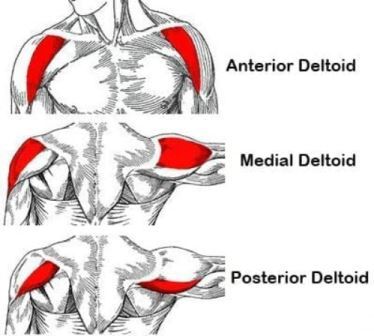
The shoulder structure is made up of three main muscle groups, consists of (Front Delts, Middle Delts and Rear Delts) whose name obviously shows their location on your shoulder muscle.
In this article, we will focus on the front and lateral deltoid exercises, which are more common and make a big difference in the appearance of the shoulders, and then briefly cover the posterior delt in one of the exercises.
In addition, we combine the best deltoid exercises that work for both the frontal (Anterior) and side (Lateral or medial) delts, and help you achieve a bigger muscles during your shoulder progress journey, and provide it the attention it deserves.
Finding the best exercises to cover shoulders is not easy, mostly with the front and side delts.
But we’ll cover you below in this article and will include the moves to grow delts muscles to maximum strength, but you need to pay attention to detail and follow the right steps.
Exercises for Building Front, Lateral and Rear Deltoid
Front Raise
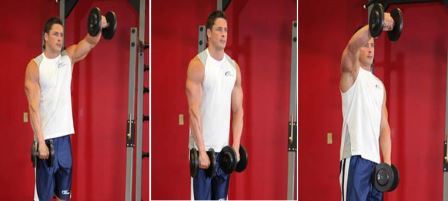
The front raise is a great at-home deltoid exercise that you will want to start with, if you are looking for straightforward delt workouts, and to focus on the anterior deltoid.
The correct move steps to keep in mind, make sure while pull the weights without bending your arms, so keep your arms extended during the entire routine, by this way the stress of the exercise will be focused on the front delts rather than your chest or triceps muscles.
Let’s start the exercise one hand at a time, with a dumbbell pronated grip (palms down) in front of your thighs, then gradually raise the weights until you are at shoulder level (make sure your arm is not bent). Then return your hands to the starting position by lowering the weights.
Lateral Raise
The second exercise that comes next logically after the front raise, is the lateral raise, which focuses on the side (lateral) delts.
Now most people do lateral exercises with both hands, this is a mistake!
The upgrade version is to focus on one arm every time. The purpose behind this is to allow access to heavier weights with a wider range of motion and better control during the routine.
Start the workout while standing straight, using dumbbells with a pronated grip, keeping the weights hanging at your sides, now begin to raise your arm to the side, then slowly return to the starting position.
To get a better exercise performance and to hit the delts effectively, be sure to lean your chest forward about 10-12 degrees, keeping your elbow slightly bent.
Behind the Neck Press
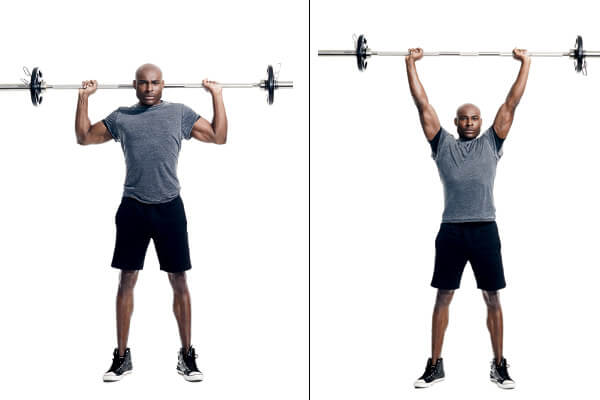
The overhead press, are a medial delt exercise, is when you lift weights behind the neck.
When you move a barbell or dumbbells behind your neck, you are actually shifting the focus of the press from the front to the lateral delt.
Start the exercise with a light weight until you practice the correct steps, with a pronated grip of the barbell a little wider than the width of your shoulders, place it behind your neck, keeping your elbows tights under the bar (make sure not slide to sides), do not move them backwards during the exercise.
Now press the weight up until your hands are fully extended, then lower the bar until it touches the top of your shoulders. Then repeat.
If you do not have a fitness bar, try to find another alternative such as a metal pipe or a wooden bar that is heavy enough and will allow you to start your workout.
Arnold Press
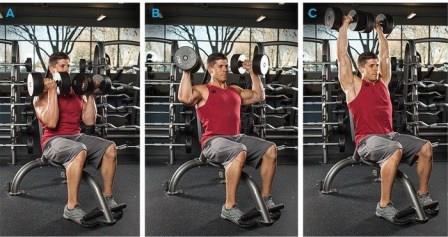
It is a popular yet worthy exercise to practice, and is the best way to perform while seated, so you can save your strength for heavy weights and to perform at your best, while standing still available if you want to engage your core.
The exercise is a compound lift, because the motion designed by the Arnold exercise, is to hit both the front and lateral delts through the lift in same time, making it the best time-saving deltoid exercise by working two delts in one exercise.
- Start perform the exercise while you are seated.
- Keep your back straight.
- Grab two dumbbells with a hammer grip and place them on your thighs.
- Raise the dumbbells straight (palm facing you) with arms bent, in front of your chest at a level slightly below your shoulders. This is the starting position.
- Now raise and push the dumbbells, while gradually rotating your hands until you reach above of your head (palms against you) while reach on top, make both sides of the dumbbells to touching each other.
- Freeze this position for a while.
- Then gradually reverse the same motion until you return to the starting position.
- Repeat the exercise 6 times in 3 sets.
Shoulder Press
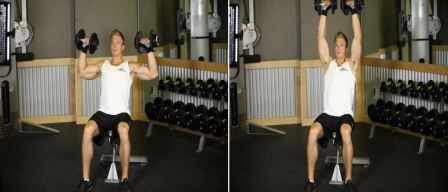
It is a common and basic exercise that can not be dropped in any shoulder workouts, and most importantly it is a compound exercise that hits the three shoulder muscles of the front, side and rear delts, all in one exercise. Means that exercises for the posterior deltoid muscle can be performed using the classic shoulder press.
There are many variations of the shoulder press, but the most popular one, is the shoulder press with a barbell or dumbbells. Today we will be discussing the most commonly used standing dumbbell shoulder press, which will provide you with a more stable form while performing with the safest range of motion.
- Begin the exercise by picking two suitable dumbbells.
- Raise both dumbbells to the head sides slightly above the level of your shoulders, with an pronated grip (starting position) by set elbows at 90 degree.
- Now start to push-up the weights above your shoulders until your arms are fully extended.
- Then gradually return to the starting position, placing the weights close to the level of your shoulders.
Upright Dumbbell Row
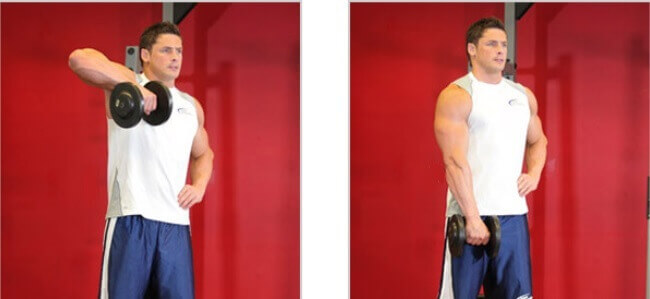
This exercise has a great potential for strength, but you need to do it right. The best way to perform is with one arm swing each time for better control and to maintain the best range of motion while focusing on one arm.
It is an isolation exercise, focusing mainly on the lateral delts (with a slight change during the performing, by bending your chest slightly) and which provides an opportunity to workout with heavy weights, hitting the muscles at different angles and different resistances to develop effective delts.
How to perform Upright Dumbbell Row:
- Begin the exercise by picking one dumbbell by grab it with one hand, and holding a chair or a rack with the other hand for support.
- Lean forward with your chest at a 45-degree angle, with your back straight, keeping the weight hanging down (starting position)
- Pull the weight until chest level, making sure your elbow is always on your side, not at your backwards.
- Slowly lower the back weights to the starting position.
Perform Front, Lateral, Rear Deltoid Workout Session
I have prepared 3 exercises from the topics that covered in this post, which will cover the 3 delts, you can try with medium weights.
- Dumbbell Lateral Raise
- Arnold Press
- Shoulder Press
Do 3 sessions of each exercise (10,8,6) times, rest for 2 minutes and then repeat. Then move on to the next exercise, and go on.
Steps to Avoid Delts Injury
The muscles of the upper body are exposed to many risks during workouts, and the shoulders are one of them, and the reason behind this is from overuse activities, and the structure of these muscles contains many different sizes starting from short to medium.
And some of the exercises associated with these muscles may be difficult to perform or cause injury especially to heavy weights or possible wrong movements.
Based on this, it is important to be extra careful with some of the measurements to avoid such injuries:
- Warm up your shoulders before starting the workout.
- Do not exercise daily deltoid exercises, keep rest for at least (1-2) days.
- Avoid motions that may raise pain.
- Strengthen your rotator cuff .
Strategies to Consider while Deltoid Workout
In this part we will discuss some of the experience points of body builders during workout, to get some recommendations or shortcuts and strategies that you should be aware of while deltoid practice:
- Choose the right shoulder press to start, which is a good shoulder workout model, and start with a multi-joint motion for a reason, so that you are able to lift more weights early in your exercise, while your muscle strength level is at the highest point. This is the advice of overhead press workout as the starting stage.
- After pressing the multi-joint, go after the single-joint workouts of the lateral delts muscles.
- It is important to emphasize the idea of starting the exercise with the medial delts before drain out your strength level, and then the next exercise to hit the front and rear delts.
- Select the appropriate heavy weight that works for you, in the early stage while you are at full energy, is the best time to challenge yourself, you can either start working out with lighter weights for higher reps, but if your goal is to stimulate muscle strength early, means to go to start with heavier weights.
- Choose an appropriate weight with which you can perform at least 7 repetitions correctly.
- Do not stop when the exercise fails, to gain a fiber delt strength muscles from, you need to take several sets. The best strategy for doing this, the time you reach failure, directly reduce the weight to 20% then continue your workout until your next failure, do the same each time and keep going.
Conclusion
If you’re looking to gain a massive shoulder muscles, you need to focus more on the lateral delts, as they are the bigger of the two, and the pop up is more obvious when you’re getting them a good workout.
Make sure to warm up before starting your exercise session, to avoid any injury.
Once you have completed the shoulder exercises for building front and lateral deltoid muscle, it is better to train the other muscles of the arms, Biceps, Triceps and Forearms in order to balance the physics of the upper figure.

